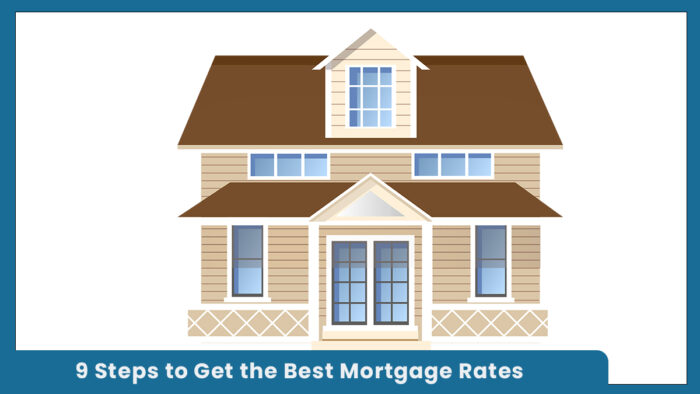Getting the best mortgage rate starts with preparing yourself for the loan application process. In the 9 Best Steps to Get the Best Mortgage Rates, you will understand that the best rates depend on your credit score, your income (measured by your debt-to-income ratio), and your assets.

These factors play a huge role in the types of rates lenders offer. After all, once you find your dream home, your mortgage rate becomes just as important as the price itself. A higher rate means you could end up paying much more over time. That is why it is so important to take control early, understand how lenders see you, and set yourself up for the best offer possible.
Even though today’s mortgage rates are higher than many buyers would like, the good news is that you are not powerless. The 9 Best Steps to Get the Best Mortgage Rates show you exactly how to position yourself for the best deal, even in a tough market.
1. Improve Your Credit Score
Improving your credit score is one of the best ways to qualify for a lower mortgage interest rate. A low score might not stop you from getting a loan, but it can lead to higher borrowing costs over time. The higher your score, the more confident lenders are in your ability to repay the loan, and the better the rate you are likely to get.
To qualify for a conventional mortgage, you usually need a credit score of at least 620. However, the best rates typically go to borrowers with scores of 740 or higher. Even a small change of 20 points can move your rate by 0.25 percent, which could mean paying thousands more over the life of a loan.
To strengthen your credit score:
- Always pay your bills on time.
- Pay down or clear credit card balances.
- Keep your credit use under 20 to 30 percent of your limit.
- Check your credit reports often and fix any errors you find.
If you are looking for a home and your credit needs improvement, consider waiting a little while to boost your score. Even a few months of financial focus can lead to major savings when you are ready to buy.
2. Gather Information on Your Income and Employment History
To qualify for a mortgage, lenders usually want to see at least two years of steady income and employment. If you are a salaried employee, you will need to provide recent pay stubs, W-2 forms, and tax returns from the past two years. Lenders also verify your employment to confirm stability.
If you are self-employed, be ready to provide extra documents like tax returns, profit and loss statements, and a letter from your accountant. Since self-employment income is harder to verify, you might face slightly higher interest rates.
If you have a job offer or are returning to work, lenders may still approve you if your offer includes clear salary details. However, large employment gaps or major career changes could make approval harder.
3. Make a Large Down Payment
Saving for a larger down payment can lower your mortgage rate and reduce your monthly payment. Ideally, a 20 percent down payment means you won’t have to pay for private mortgage insurance (PMI), which typically adds 0.46 to 1.5 percent of your loan amount annually.
If you’re a first-time homebuyer and can’t manage 20 percent, there are various programs and loans designed to assist with down payments, often based on factors like income and homebuyer status. The more you put down, the less interest you’ll pay over time, making your home more affordable in the long run.
4. Understand Your Debt-to-Income Ratio
Your debt-to-income (DTI) ratio compares your monthly debt payments to your gross monthly income. Lenders typically want your mortgage payment to be no more than 28% of your gross income, and your total debt payments should stay below 36%.
For example, if you earn $4,000 per month, your mortgage payment should not exceed $1,120 (28% of $4,000). Your total debt payments, including your mortgage and any other debts, should be below $1,440 (36% of $4,000).
While the maximum DTI for conventional loans is 45% and 43% for FHA loans, exceptions may apply if you have significant savings.
5. Consider Paying Points
Discount points are upfront fees you can pay to lower your mortgage interest rate. One point typically costs 1% of the loan amount and can reduce your rate by about 0.25%, though the exact reduction may vary.
Paying for points means you’ll pay a higher amount upfront, but you’ll save on your monthly mortgage payments. The more points you buy, the greater your savings. However, it can take several years for the savings to outweigh the initial cost.
For example, if you pay $2,500 for one point on a $250,000 loan, you could reduce your interest rate by 0.25%, saving you $40 a month. The break-even point for this example would be around five years, meaning you’ll need to stay in the home that long to make it worthwhile.
Before deciding, you can use a mortgage points calculator to see if the break-even period fits with your plans. If you plan to sell or refinance before the break-even point, paying points may not be worth it.
6. Shop Around with Multiple Lenders
Don’t settle for the first rate you’re offered. Instead, get quotes from at least three different lenders. It’s important to compare offers from multiple lenders. By applying for preapproval with a few different lenders, you can compare their rates and terms, helping you choose the one that offers the best deal for your needs.
Start by checking with your own bank or credit union, but also reach out to other mortgage lenders and explore online options. As you gather quotes, you’ll notice that even if interest rates seem similar, the fees, closing costs, and private mortgage insurance premiums can vary. Comparing these details helps you find the offer that saves you the most money overall.
7. Consider Alternative Mortgage Options
A 30-year fixed-rate mortgage is the most common choice for homebuyers, but it is not your only option. Other types of mortgages could offer lower interest rates depending on your situation.
For example, adjustable-rate mortgages (ARMs) often start with a lower fixed rate for the first few years before adjusting periodically. A 5/6 ARM, for instance, offers a fixed rate for five years before adjusting every six months. This could be a smart move if you plan to sell the home before the adjustment period begins, but it could become costly if you stay longer and rates rise.
Choosing a shorter loan term, like a 15-year mortgage, can also lead to lower rates compared to a 30-year loan. Your monthly payments will be higher, but you will save money in the long run by paying less interest.
Government-backed loans, such as FHA loans, may offer lower rates and easier qualification standards. However, you will need to pay mortgage insurance. If you can make a down payment of 10 percent or more, you can cancel the insurance after 11 years. Otherwise, it remains for the life of the loan unless you refinance.
You might also look into shared appreciation mortgages (SAMs). With this option, you agree to give the lender a portion of your home’s future increase in value in exchange for a lower interest rate. It can reduce your costs now, but if your home’s value rises significantly, you could end up paying much more later.
8. Use a Mortgage Calculator
Before you commit to a loan, it is smart to use a mortgage calculator to get a clear idea of what your monthly payments might look like. By entering different numbers, like the loan amount, interest rate, and down payment, you can play around with different scenarios to find a mortgage that fits your budget comfortably. For instance, you might realize that by making a larger down payment, you could afford the slightly higher payments of a 15-year mortgage and save big on total interest over time.
9. Consider Interest Rates and Closing Costs
While the interest rate is a major factor, it is not the only thing you should focus on. Look closely at the full picture, including any prepayment penalties if you decide to refinance later and the total closing costs you will need to pay upfront.
Bottome Line On 9 Steps to Get the Best Mortgage Rates
Before getting a mortgage loan, it is recommended that you read through the 9 Best Steps to Get the Best Mortgage Rates thoroughly. With this you can be well informed on how to go about your mortgage application process.



